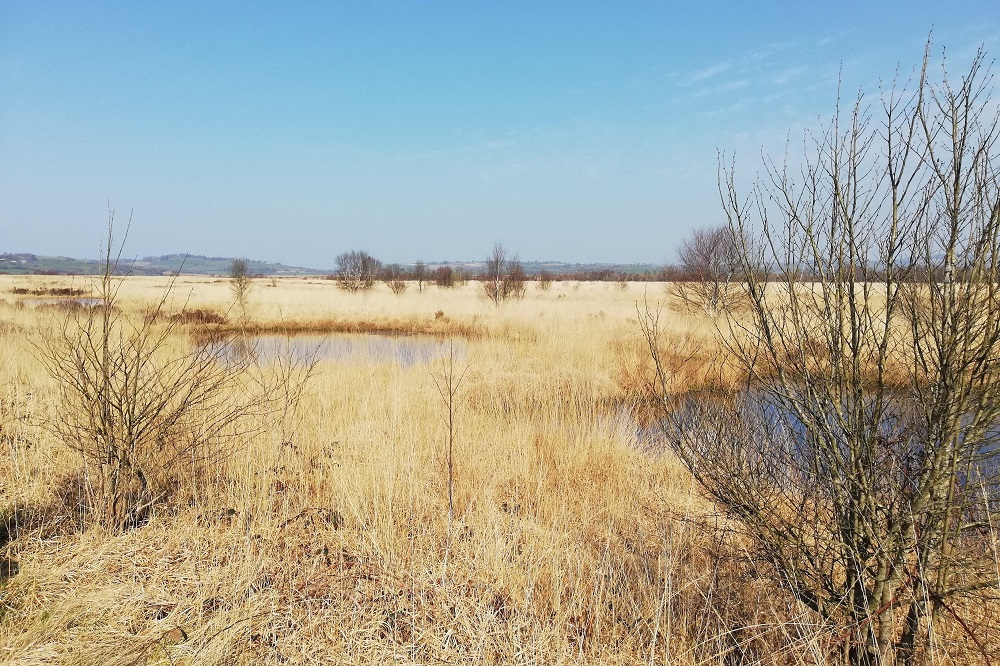For peat’s sake: Lottie Williams explores the ancient bogs of Cors Caron

Lottie Williams
Cors Caron National Nature Reserve is a beautiful Welsh rarity that is world famous. Located within the Teifi Valley near Tregaron, Ceredigion, this natural wonder boasts three raised peat bogs that have been built up over the last 12,000 years.
In some places the peat is a staggering 10 metres deep and is one of the best examples of intact bog in Britain.
It is mid Spring when we drive from Tregaron into the valley and, I must admit, my first views are surprising. I’m not sure what I was expecting to be honest, perhaps a black mass of ground akin to my squelchy homeland moors of Yorkshire, or the drained Fen soil where I grew up. But no. Instead, a tussocked rug of amber straw stretches out before us, the light haloing the grasses which grow on the bog with an aura of acknowledged importance.
The soft yellow glow warms three square miles beneath a cottonflower blue sky, the surrounding valley sloping up in mottled haze. Cors Caron is stunning.
We park up and observe the information boards. There are three walks to choose from, each different in accessibility and length, and we excitedly choose to incorporate them all. This is not necessary, but we find ourselves child free for a few hours and so relish in this unaccustomed freedom.
Firstly, the aptly named ‘Cors Caron Walk’ takes us along a recently improved boardwalk through the most impressive parts of the bog. After visiting a bird hide, we continue onto the ‘Riverside Walk’ which convoys the meandering River Teifi, and finally joins the ‘Old Railway Walk’ back to the car park.

‘Cors Caron Walk’ begins along an avenue of trees: willows boasting fat furry catkins that puff like popcorn; large gnarly oaks which claw the sky; coppiced hazel spears.
A peacock butterfly basks in the sun, wings outstretched in the welcoming Spring warmth, four bright eyespots staring at us from delicate wings. Hovering, a bee-fly sources pollen. A willow arch welcomes us onto the boardwalk and captures the golden light of the bog in delightful composition.
Ice Age
With barely a breeze, the grasses do not stir though I am caught by a sense of time, counting back thousands of years to the retreating Ice Age when this area began to take its current form.
Peat bogs keep environmental secrets enveloped within the layers of their creation. Impressively, these historical gateways give us insights into bygone plant and animal life and store huge amounts of harmful carbon that would otherwise be released back into the frail atmosphere.
Peat bogs are therefore one of our most important assets to help tackle the Climate Emergency.
Approximately 3% of the world’s landmass is covered in peatland but it stores about twice as much carbon as all of Earth’s forests. It is therefore imperative that we preserve our bogs and it is very easy to start from home: refuse to buy peat based compost and instead opt for the peat-free bag.
Throughout the raised bogs there is evidence of past peat cutting, where monks from nearby Strata Florida Abbey dug out swathes of it for fuel. Now these pits are vast dark pools, the channels blocked up so that water will not drain away.
Up close they appear bottomless, the lakes thick and dark like treacle. Rusty red sphagnum moss acts as an event horizon to the watery black holes. However, from afar, they elegantly catch the blue sky in mirrored reflection, a perfect glass surface.
The bird hide is easily the best hide I have been to. With wall to wall, floor to ceiling windows on one side, and a series of imaginative and interesting display boards about the bog’s formation along the other, our attention remains captured even though we are now inside.
Swamp
I learn how the valley of meltwater from the last Ice Age became a swamp as eroded material was deposited over time, leading to reed beds which then become woodland and, finally, bog.
Cors Caron boasts a wide range of birdlife, and we are not disappointed. A pair of Canada geese lift their heads quickly and glare as we disturb the peace with our chatter. They argue our intrusion with sharp successive honks of annoyance.
Six red kites languidly circle the sky on high unseen thermals, primary feathers splayed to catch the drifts in an effortless soar. A mute swan regally drifts along the Teifi. Despite the slow serenity of its journey, it leaves a wake of milky froth. An egret stands still at the side of a pool, long dark legs stark against its slender white plumage and question mark neck. A grey heron flies over us then circles back, wing beats slow and deep.
Aerobatics
But the ultimate spectacle is when a hen harrier dives towards us with astonishingly agile aerobatics. Torpedoing its body around, a twisting tornado of feathers, it spirals in skydance. Suddenly, large wings open and trap the air underneath its body like an upturned parachute, whooooomph!, and the bird pumps away, adrenaline coursing us all.
This day will remain with me, though it is hard to disassociate the beauty from human impact. The peat is substantial, but evidence of man’s disturbance is present in the deep dark excavation pools.
Where native wildwood grew on the rolling valley sides surrounding the raised bogs, there is now extensive farmland and modern plantation. Only tiny pockets of ancient woodland remain. But there is a future here, and Cors Caron is part of the Welsh Raised Bogs Project, a restoration initiative to ensure that this environmentally important habitat is protected.
Thankfully, Cors Caron is once again actively growing.
Support our Nation today
For the price of a cup of coffee a month you can help us create an independent, not-for-profit, national news service for the people of Wales, by the people of Wales.




